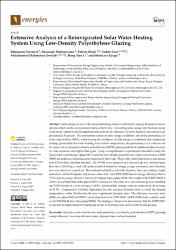| dc.contributor.author | Duraivel, Balamurali | |
| dc.contributor.author | Muthuswamy, Natarajan | |
| dc.contributor.author | Shaik, Saboor | |
| dc.contributor.author | Cüce, Erdem | |
| dc.contributor.author | Owolabi, Abdulhameed Babatunde | |
| dc.contributor.author | Li, Hong Xian | |
| dc.contributor.author | Kavgic, Miroslava | |
| dc.date.accessioned | 2023-09-14T05:45:34Z | |
| dc.date.available | 2023-09-14T05:45:34Z | |
| dc.date.issued | 2023 | en_US |
| dc.identifier.citation | Duraivel, B., Muthuswamy, N., Cüce, E., Owolabi, A.B., Li, H.X., Kavgic, M. (2023). Extensive Analysis of a Reinvigorated Solar Water Heating System Using Low-Density Polyethylene Glazing. Energies,16(16), 5902. https://doi.org/10.3390/en16165902 | en_US |
| dc.identifier.issn | 1996-1073 | |
| dc.identifier.uri | https://doi.org/10.3390/en16165902 | |
| dc.identifier.uri | https://hdl.handle.net/11436/8327 | |
| dc.description.abstract | Solar energy is one of the most promising forms of alternative energy because it has no adverse effects on the environment and is entirely free. Converting solar energy into thermal energy is the most common and straightforward method; the efficiency of solar thermal conversion is approximately 70 percent. The intermittent nature of solar energy availability affects the performance of solar water heaters (SWH), which lowers the usefulness of solar energy in residential and commercial settings, particularly for water heating. Even at low temperatures, the performance of a collector can be improved by using low-density polyethylene (LDPE) glazing instead of traditional glass because it is less expensive and lighter than glass. Using a comprehensive experimental-simulative study, the Glass Solar water heater (glass SWH) and the low-density polyethylene solar water heater (LDPE SWH) are analyzed, examined, and compared in this work. These solar water heaters have galvanized iron (GI) as their absorber material. The SWHs were operated in a closed loop at a constant mass flow rate of 0.013 kg/s, and a 4E analysis (which stands for energy, exergy, economics, and efficiency recovery ratio) was carried out. This analysis included a look at the dynamic time, uncertainty, weight reduction, carbon footprint, and series connection. An LDPE SWH has an energy efficiency that is 5.57% and an exergy efficiency that is 3.2% higher than a glass SWH. The weight of the LDPE SWH is 32.56% lower than that of the glass SWH. Compared to the price of a conventional geyser, installing our SWH results in a cost savings of 40.9%, and monthly energy costs are reduced by an average of 25.5%. Compared to October, September has the quickest dynamic time to reach the desired temperature, while October has the most significant dynamic time. The efficiency recovery ratio (ERR) of a glass SWH is 0.0239% lower than that of an LDPE SWH. LDPE SWHs had a carbon credit worth INR 294.44 more than glass SWHs. The findings of these tests demonstrate that the LDPE SWH is a practical replacement for traditional means of heating water, such as SWHs and geysers. | en_US |
| dc.language.iso | eng | en_US |
| dc.publisher | MDPI | en_US |
| dc.rights | info:eu-repo/semantics/openAccess | en_US |
| dc.subject | Carbon footprint | en_US |
| dc.subject | Dynamic time | en_US |
| dc.subject | Exergy efficiency | en_US |
| dc.subject | Flat plate solar water heater | en_US |
| dc.subject | Low-density polyethylene (LDPE) glazing | en_US |
| dc.subject | Recovery efficiency ratio | en_US |
| dc.subject | Transmissivity | en_US |
| dc.title | Extensive analysis of a reinvigorated solar water heating system using low-density polyethylene glazing | en_US |
| dc.type | article | en_US |
| dc.contributor.department | RTEÜ, Mühendislik ve Mimarlık Fakültesi, Makine Mühendisliği Bölümü | en_US |
| dc.contributor.institutionauthor | Cüce, Erdem | |
| dc.identifier.doi | 10.3390/en16165902 | en_US |
| dc.identifier.volume | 16 | en_US |
| dc.identifier.issue | 16 | en_US |
| dc.identifier.startpage | 5902 | en_US |
| dc.relation.journal | Energies | en_US |
| dc.relation.publicationcategory | Makale - Uluslararası Hakemli Dergi - Kurum Öğretim Elemanı | en_US |


















